You might call me a little crazy. You might also call me a little geeky. You’d be right on both counts, and proud of it. It’s who I am–and if I wasn’t, I wouldn’t be here to do crazy things like bake 18 cakes in one day for your benefit.

Yes, you read that correctly. Last summer I baked 18 cakes in one day so that I could directly compare every egg replacement I’d ever heard of. (At least, all the safe ones. I’ve heard people use peanut butter, but that ain’t kosher in our house.) Ever since Zax was diagnosed with his egg allergy at the age of 10 months, I’ve been on a quest to discover the best egg replacer. Over the years I’ve tried quite a few of them, both store-bought and homemade.
For some purposes, there are clear winners. To apply a breading to meats, for example, sticky replacements like flax seed work best. For whipping/meringue recipes, aquafaba is the best–indeed, the only–replacer that works. Other foods are more forgiving. Cookies, for example, tend to turn out okay regardless of what you use. Pancakes too.
But cake–well, cake is often an adventure.
Sometimes the cake doesn’t rise. Sometimes it crumbles the moment it’s touched. Sometimes it tastes or feels weird. If you’re really unlucky, you’ll get all three.
The Wacky Cake is one of my favorite egg-free cakes, but sometimes we want to go beyond its capabilities (or we don’t want to bake from scratch.) So I decided to turn on my experimental brain and try a side-by-side experiment to find out just which egg replacer works best with a box of cake mix. So I present:
The Great Cake Experiment
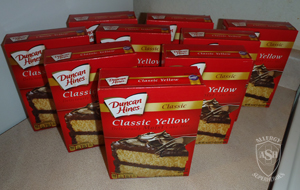 I started with nine boxes of Duncan Hines Classic Yellow Cake Mix. The only major allergen in this mix is wheat, and they told me when I called that they shut the lines down for an eight hour cleaning process in the rare event that they run something with other allergens on the same lines. I know some people don’t trust Duncan Hines’ policy because they don’t list which allergens might share the lines–and that’s fine, use whichever cake mix works for you.* I’m not here to recommend a cake mix, I’m recommending the egg replacements!
I started with nine boxes of Duncan Hines Classic Yellow Cake Mix. The only major allergen in this mix is wheat, and they told me when I called that they shut the lines down for an eight hour cleaning process in the rare event that they run something with other allergens on the same lines. I know some people don’t trust Duncan Hines’ policy because they don’t list which allergens might share the lines–and that’s fine, use whichever cake mix works for you.* I’m not here to recommend a cake mix, I’m recommending the egg replacements!
*Be aware, though, that a cake made without eggs or gluten is very likely to not behave itself. Without the rising-and-binding power of real eggs or the elasticity of gluten, there isn’t really much that’s going to help hold a cake together. That’s why most gluten-free products contain egg, and avoiding both is very difficult. If you’re looking for something you can use with a gluten-free cake mix, use this as a starting point but expect results to be different.
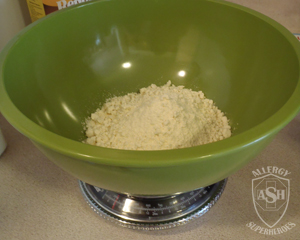 I divided each box of cake mix in half, using a kitchen scale to ensure it was even. For each half-box of mix, I made one 9″ round cake. I also live and bake at high altitude, so I followed the high altitude directions and added 1/3 cup flour to each box (1/6 cup to each half.)
I divided each box of cake mix in half, using a kitchen scale to ensure it was even. For each half-box of mix, I made one 9″ round cake. I also live and bake at high altitude, so I followed the high altitude directions and added 1/3 cup flour to each box (1/6 cup to each half.)
Each box called for 3 eggs, so I had to calculate 1 1/2 eggs worth of each corresponding egg replacer. I also added 1/8 cup (2 Tbsp) canola oil and 1/2 cup water, as per package directions (unless an egg replacer was meant to replace all add-ins in the box.)
Of course, this experiment would not be complete without being able to compare the replacements to the real thing. Hubby, Kal, and I can all still eat eggs, so my very last cake used real eggs, for the control. (It was interesting measuring 1 1/2 of them, let me tell you!)
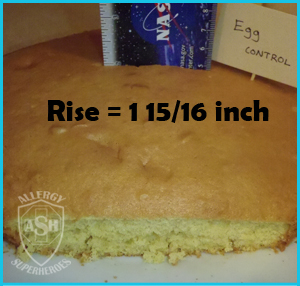 As my day-long baking adventure shows, there’s unfortunately nothing that works quite like real eggs. That cake rose the highest, and held together the best.
As my day-long baking adventure shows, there’s unfortunately nothing that works quite like real eggs. That cake rose the highest, and held together the best.
However, it’s actually GOOD NEWS that there is no clear winner, although there were some clear losers. A half-dozen replacements worked just as well as each other. This means that if you’re allergic to some of these options, if you avoid them for ethical or personal reasons, or if you just can’t find a source that isn’t contaminated with your other allergens, there ought to be another good option that works for you.
As you can see below, each replacement has its own pros and cons. The replacers I used, our observations, and the results (in the order that I tried them) are below. Or you can scroll to the end to see the Summary and Conclusions!
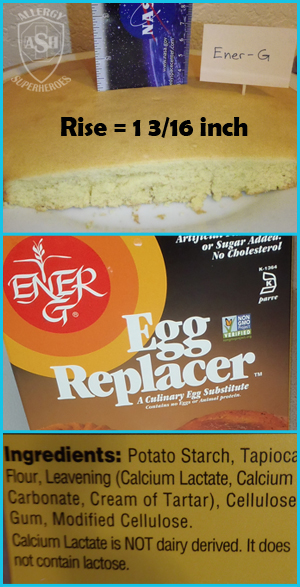 Egg Replacer Name: Ener-G Egg Replacer
Egg Replacer Name: Ener-G Egg Replacer
What is it? A vegan, commercially available, plant-based combination of starches, leavening agents, and binders.
Proportions: 1/2 Tbsp Ener-G powder plus 2 Tbsp water = 1 egg
Instructions: Combine powder with water. Can be mixed with a fork or spoon, but works best when whipped with a hand-mixer or blender.
Rise: 1 3/16 inch
Texture: Very soft, a little denser than real eggs
Bind: More apt to crumble
Taste: Does not add any discernible taste of its own
Pros: Commercially available; easy–just mix and go; Top 8 Allergen Free; Gluten Free; Vegan
Cons: Rise is not as good as other options; cakes fall apart more easily
Notes: Ener-G is the only store-bought egg replacer I used in this experiment. Of those that I had tried prior to this time, Ener-G performed the best, so it is the only one that I used. Many others wouldn’t rise and would completely fall apart. However, since this marathon of cake baking, there are several more store-bought replacers available, and it is possible that some of them would perform better.
Our Observations:
Zax: Yum!
Kal: Liked better than egg
Eileen: Very soft
Dean: Denser, not as spongy
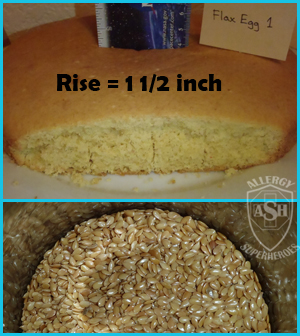 Egg Replacer Name: Flax Egg #1
Egg Replacer Name: Flax Egg #1
What is it? Ground flax seed mixed with water
Proportions: 1 Tbsp ground flax seed plus 3 Tbsp water = 1 egg
Instructions: Measure flax AFTER grinding. Combine ground flax seed with water, mix together, and allow to sit for 5+ minutes, until it gels.
Rise: 1 1/2 inch
Texture: Still soft and spongy but with a slightly harder “crust”
Bind: Crumbles a bit, crumbles into smaller pieces
Taste: Adds no real discernible taste
Pros: One of the best rises of all replacers; Easy to find at many stores; Top 8 Allergen Free; Gluten Free; Vegan
Cons: Have to grind yourself, which takes more time; Have to let it gel, which takes more time; Cannot grind large batches in advance as ground seeds will go rancid quickly; Is a seed, which can be allergenic; May be difficult to find flax seeds that don’t carry a cross-contamination risk with other allergens
Our Observations:
Zax: Crust is harder
Kal: Yum!
Eileen: Soft, but harder crust?
Dean: Spongier, little more crumbly
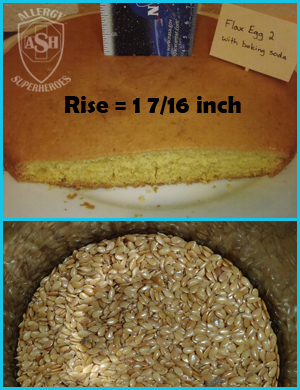 Egg Replacer Name: Flax Egg #2
Egg Replacer Name: Flax Egg #2
What is it? Same as above but with the added leavening power of baking soda
Proportions: 1 Tbsp ground flax seed, 1/4 tsp baking soda, and 3 Tbsp water = 1 egg
Instructions: Measure flax AFTER grinding. Combine ground flax seed, baking soda, and water. Mix and allow to sit for 5+ minutes, until it gels.
Rise: 1 7/16 inch
Texture: A little drier and not as airy as flax without baking soda
Bind: Roughly the same as flax without baking soda: Crumbles a bit, crumbles into smaller pieces
Taste: Adds no real discernible taste
Pros: Good rise; Flax seed is easy to find at many stores, baking soda is available everywhere; Top 8 Allergen Free; Gluten Free; Vegan
Cons: The baking soda added no noticeable benefit–the cake rose slightly less than flax without eggs. Plus cons above: Have to grind yourself, which takes more time; Have to let it gel, which takes more time; Cannot grind large batches in advance as ground seeds will go rancid quickly; Is a seed, which can be allergenic; May be difficult to find flax seeds that don’t carry a cross-contamination risk with other allergens
Notes: In both flax and chia cases, the baking soda caused a slight reduction in rise–by 1/16th inch–which is not what one would expect. My kitchen is not completely precise, so it is possible this resulted from those mixes having had slightly less batter. It is also possible that with the added baking soda, the cake rose too fast and then sunk slightly (this is a common problem at high altitude). My last hypothesis would be that baking soda and seeds just don’t work all that well together. Regardless of the cause, my conclusion is to not bother adding baking soda to seed egg replacers!
Our Observations:
Zax: Crust is harder than the first flax egg
Kal: Yum!
Eileen: Similar to the first flax egg, but feels a little drier
Dean: Not as airy as the first flax egg
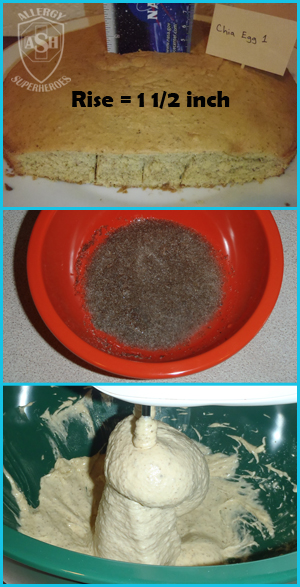 Egg Replacer Name: Chia Egg #1
Egg Replacer Name: Chia Egg #1
What is it? Ground chia seeds mixed with water
Proportions: 1 Tbsp ground chia seeds plus 3 Tbsp water = 1 egg
Instructions: Measure chia seeds AFTER grinding. Combine ground seeds with water, mix together, and allow to sit for 15 minutes, until it gels.
Rise: 1 1/2 inch
Texture: Denser and chewier, plus you can feel the seeds
Bind: VERY sticky as a batter–it climbed up the beaters and threatened to touch the motor; Cake holds together pretty well
Taste: Either you can taste the seeds, or just feeling the seeds crunch distracts from the taste of the cake–but only a little
Pros: Great bind without losing rise; good rise; Ground chia seeds last longer than ground flax, so you can grind in advance and save for future use; Top 8 Allergen Free; Gluten Free; Vegan
Cons: Produces a denser cake; Cake has visible freckles, which could be a turn-off to picky kids; Seeds provide a grainy crunch, which again can be a turn-off for cake; Grinding and gelling the chia mix takes longer; Is a seed, which can be allergenic; May be difficult to find, most likely will have to go to a health food store; May be hard to find chia seeds that don’t carry a cross-contamination risk with other allergens
Our Observations:
Zax: Crust is hard but not as hard as the flax cake
Kal: Yum!
Eileen: Denser/chewier; you can see and feel the little black seeds
Dean: Denser; not as airy/as many air pockets; you can see the spots; the seeds crunch; it’s weird
 Egg Replacer Name: Chia Egg #2
Egg Replacer Name: Chia Egg #2
What is it? Same as above but with the added leavening power of baking soda
Proportions: 1 Tbsp ground chia seeds, 1/4 tsp baking soda, and 3 Tbsp water = 1 egg
Instructions: Measure chia seeds AFTER grinding. Combine ground seeds, baking soda, and water together. Allow to sit for 15 minutes, until it gels.
Rise: 1 7/16 inch
Texture: Denser and chewier; you can feel the seeds, as above
Bind: Very good bind for a cake; as above, batter is sticky and clings to the mixer
Taste: Tastes a little off from regular cake, possibly from the extra baking soda; also as above, you can taste/feel the individual seeds, which can be distracting.
Pros: Same as above: Great bind without losing rise; good rise; Ground chia seeds last longer than ground flax, so you can grind in advance and save for future use; Top 8 Allergen Free; Gluten Free; Vegan
Cons: The baking soda added no noticeable benefit–the cake rose slightly less than chia without eggs. Plus same as above: Produces a denser cake; Cake has visible freckles, which could be a turn-off to picky kids; Seeds provide a grainy crunch, which again can be a turn-off for cake; Grinding and gelling the chia mix takes longer; Is a seed, which can be allergenic; May be difficult to find, most likely will have to go to a health food store; May be hard to find chia seeds that don’t carry a cross-contamination risk with other allergens
Notes: In both flax and chia cases, the baking soda caused a slight reduction in rise–by 1/16th inch–which is not what one would expect. My kitchen is not completely precise, so it is possible this resulted from those mixes having had slightly less batter. It is also possible that with the added baking soda, the cake rose too fast and then sunk slightly (this is a common problem at high altitude). My last hypothesis would be that baking soda and seeds just don’t work all that well together. Regardless of the cause, my conclusion is to not bother adding baking soda to seed egg replacers!
Our Observations:
Zax: Great! Can see the spots but not bothered by them; likes this better than all but Ener-G so far
Kal: Yum!
Eileen: Tastes just a little off; Denser
Dean: Denser; top is thick; see the spots; it holds together really well
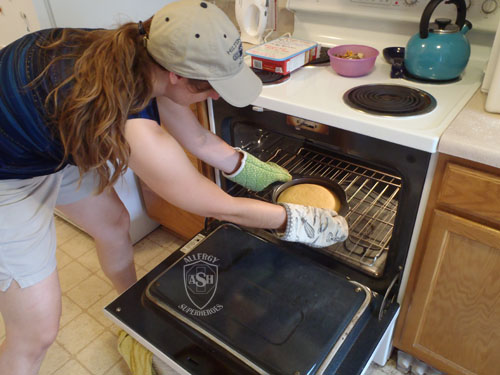
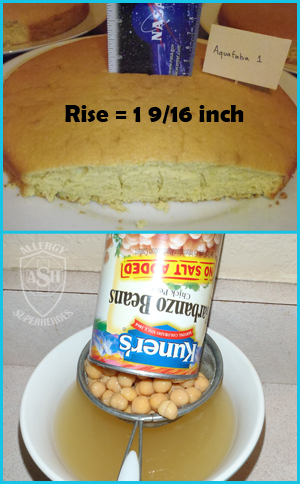 Egg Replacer Name: Aquafaba #1
Egg Replacer Name: Aquafaba #1
What is it? The cooking water from garbanzo beans–simply save the liquid when you drain a can! You can also save your own cooking water, though you probably want to reduce it before using. The liquid from other legumes works too.
Proportions: 3 Tbsp aquafaba = 1 egg
Instructions: Drain from can and add directly to recipe
Rise: 1 9/16 inch
Texture: Produces a very soft cake, even the crust is soft
Bind: Has a decent bind but a little more prone to crumbling
Taste: Tastes like cake, adds no bean taste or discernible taste of its own
Pros: Available for free with your garbanzo beans; works with other beans/legumes as well; available at any grocery store; Easy; Rises well; Produces a soft cake with a very close texture to a normal cake with eggs; Top 8 Allergen Free; Gluten Free; Vegan
Cons: Is a legume, which can be allergenic–or some peanut-allergic folks can be cross-reactive with other legumes
Our Observations:
Zax: Softer, is as soft as Ener-G
Kal: Super Yummy!
Eileen: Softer; crust is softer; tasty; nice and light; no bean taste
Dean: Spongier; pulls apart nicely; no hint of bean; soft crust
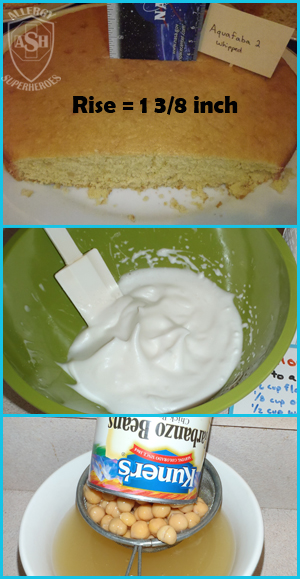 Egg Replacer Name: Aquafaba #2
Egg Replacer Name: Aquafaba #2
What is it? The whipped cooking water from garbanzo beans–simply save the liquid when you drain a can! You can also save your own cooking water, though you probably want to reduce it before using. The liquid from other legumes works too.
Proportions: 3 Tbsp aquafaba = 1 egg
Instructions: Place aquafaba in a large bowl and whip with a whisk attachment on a mixer for 10ish minutes, until soft peaks form. Then add other ingredients as usual.
Rise: 1 3/8 inch
Texture: Produces a very soft cake, even the crust is soft
Bind: Has a decent bind but a little more prone to crumbling
Taste: Tastes like cake, adds no bean taste or discernible taste of its own
Pros: Same as above: Available for free with your garbanzo beans; works with other beans/legumes as well; available at any grocery store; Easy; Rises well; Produces a soft cake with a very close texture to a normal cake with eggs; Top 8 Allergen Free; Gluten Free; Vegan
Cons: Takes a long time to whip; plus same as above: Is a legume, which can be allergenic–or some peanut-allergic folks can be cross-reactive with other legumes
Notes: Aquafaba was recently discovered, in March 2015, as a new “Miracle” egg replacer that could whip like egg whites (for meringues and other, similar recipes.) It is the only egg replacement that currently has that property. It works as a general egg replacement as well. I tried it a second time here to see if whipping before use would benefit the cake in any way. The 3/16 inch shorter rise indicates that it does not benefit the cake and isn’t worth the time it takes to whip it (it could also mean, as above with the chia and flax seeds, that the batter mixes were not divided precisely in half.)
Our Observations:
Zax: Softer; crust very soft; middle very very soft; Likey likey; Yummy yummy
Kal: I want to eat all of it, super yummy!
Eileen: Soft and spongy; Not really worth it to whip as there’s no real discernible difference to the other aquafaba
Dean: No bean flavor; agreed, no real difference to Aquafaba 1
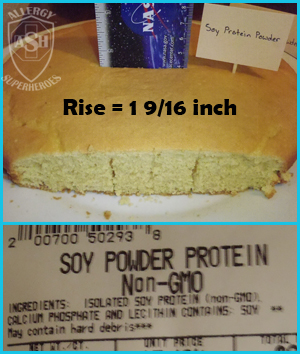 Egg Replacer Name: Soy Protein Powder
Egg Replacer Name: Soy Protein Powder
What is it? Dried, dehulled, and defatted soybeans
Proportions: 1 Tbsp Soy Protein Powder plus 3 Tbsp water = 1 egg
Instructions: Mix together until smooth
Rise: 1 9/16 inch
Texture: Slightly denser cake with a thicker, more crust-like crust
Bind: Decent–not as strong as some but doesn’t fall apart
Taste: Adds no discernible taste
Pros: Good rise; easy–just mix and go; Gluten Free; Vegan
Cons: Contains soy, one of the Top 8 Allergens; most varieties will be GMO; denser cake; harder to find, mostly at health food stores; it may be even harder to find a brand that doesn’t carry cross-contamination risks with other allergens
Our Observations:
Zax: Can’t really tell anymore
Kal: Yum!
Eileen: Thicker; denser crust
Dean: Slightly denser; very crust-like crust; tastes good
 Egg Replacer Name: Agar Agar
Egg Replacer Name: Agar Agar
What is it? An extract from seaweed, or more specifically from algae, which has thickening and gelling properties that make it a good vegan substitute for gelatin.
Proportions: 1 Tbsp Agar Agar plus 1 Tbsp water = 1 egg
Instructions: Whip water and agar agar together to dissolve, chill, and whip again
Rise: 1 1/4 inch
Texture: Soft but a bit denser, with a tiny bit of gumminess/chewiness
Bind: Crumbles a fair bit–way more than one would expect, considering this is supposed to behave like gelatin
Taste: Adds no discernible taste
Pros: Top 8 Allergen Free, Gluten Free, Vegan
Cons: Difficult to find–definitely something from a specialty store or health food store; have to mix and chill, which takes longer; difficult to get all the flakes to dissolve; crumbles far too easily for something that is supposed to behave like gelatin
Notes: Even though I got the agar agar mixed and chilling while I worked on another cake, I felt like I could still feel a few flakes in the finished product. This may require even more time to fully dissolve. I have since learned it is also available in powder form, which would dissolve more easily.
Our Observations:
Zax: Yum!
Kal: Yum!
Eileen: Soft but a little denser/chewier; more crumbly; can I feel some flakes?
Dean: Denser; crust not too bad; subtly gummy?
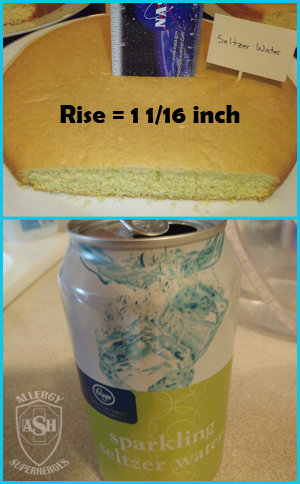 Egg Replacer Name: Seltzer Water or Soda
Egg Replacer Name: Seltzer Water or Soda
What is it? The carbonated seltzer water that gets mixed with sugary syrup to make soda. You can also choose a sugary soda of a flavor that compliments your cake.
Proportions: 1 12oz can of seltzer water replaces ALL ADD-INS in a box of cake. (THIS IS NOT A DIRECT EGG REPLACEMENT!)
Instructions: Combine one 12oz can of seltzer water with dry cake mix, stir until blended, and bake as usual
Rise: 1 1/16 inch
Texture: Soft but dense, with a chewy/gummy crust
Bind: Pretty good
Taste: Seltzer water is pretty neutral. You could use Sprite to make a cake even sweeter, or use a flavored soda to impart some of that flavor to the cake
Pros: Easy–don’t have to measure anything else; Availability–soda can be found everywhere; Top 8 Allergen Free; Gluten Free; Vegan
Cons: Doesn’t rise as much; texture of crust is a little off; Soda–particularly if you use sweet soda–isn’t very healthy, but on the other hand we’re already talking about cake
Our Observations:
Zax: Crust soft; middle super soft; very yummy!
Kal: I like it so much I want to eat all of it!
Eileen: Crust thicker; crust more gummy than hard
Dean: Pretty dense; middle is spongy; crust isn’t hard, but is dense and chewy
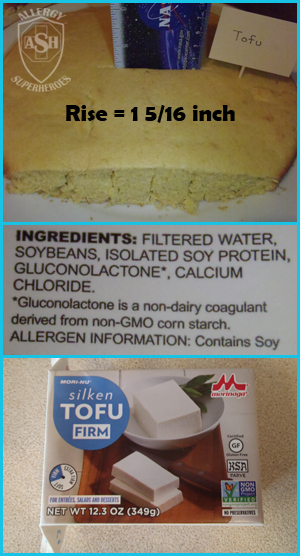 Egg Replacer Name: Silken Tofu
Egg Replacer Name: Silken Tofu
What is it? Bean curd. Soy milk is coagulated, and the resulting curds are pressed into blocks. Vegetarian source of protein.
Proportions: 1/4 of a block of Silken Tofu = 1 egg
Instructions: Puree silken tofu until smooth
Rise: 1 5/16 inch
Texture: Soft but dense, more chewy
Bind: Crumbles a lot
Taste: Tastes off, tofu perhaps overpowers the sweet flavor of the cake
Pros: Available at health food stores and many regular grocery stores as well; Gluten free; Vegan
Cons: Funny flavor; not that great of a rise or texture; Soy is one of the Top 8 Allergens; Most varieties will be GMO
Notes: My tofu never “pureed smooth,” as stated in the directions–it just broke into smaller curds
Our Observations:
Zax: Super soft and yummy just like the last one
Kal: Yum
Eileen: Tastes a little off; soft but dense; crust soft; crumbly
Dean: Denser; pulls apart more easily; chewy; not as pronounced of a cake flavor, tofu overpowers?
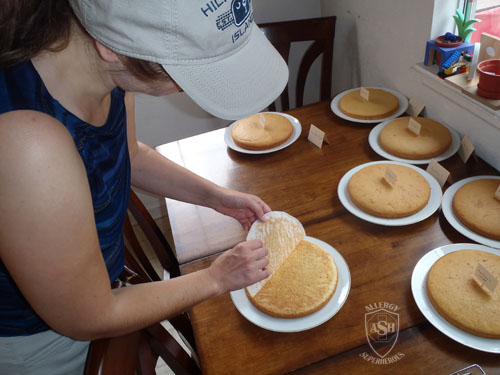
 Egg Replacer Name: Vinegar and Baking Soda
Egg Replacer Name: Vinegar and Baking Soda
What is it? An acid (vinegar) mixed with a base (sodium bicarbonate) releases carbon dioxide. This is the same chemical reaction we’ve all created when making “volcanoes” erupt for elementary school science experiments.
Proportions: 1 Tbsp Apple Cider Vinegar plus 1 tsp baking soda = 1 egg. A different vinegar could be substituted.
Instructions: Add baking soda to dry ingredients, and add vinegar with wet ingredients
Rise: 3/8 inch
Texture: Thick and dense; Crust is harder and almost like a bread crust
Bind: Falls apart
Taste: It tastes better than it looks, but has off, non-sweet undertones
Pros: Is available in just about every kitchen; Top 8 Allergen Free; Gluten Free; Vegan
Cons: Produces an ugly cake; Tastes off; Too dense; Not only does it not rise, it sinks significantly; Falls apart; Whose idea was this?; FAIL!
Notes: While this chemical reaction can help cakes rise (it’s part of the rising action in the Wacky Cake) it works better when the recipe evolves around this phenomenon. This did not work well AT. ALL. as a direct replacement for eggs.
Our Observations:
Zax: Crust really really hard; inside really really soft; tastes great!
Kal: Yum!
Eileen: Crust is thick and dense and is giving me hints of something familiar, but I can’t place it; thicker on the edges than in the middle; crumbly
Dean: Crust is almost like bread crust; flavor is off; also hints of a familiar non-sweet flavor; center is spongy
 Egg Replacer Name: Yogurt
Egg Replacer Name: Yogurt
What is it? Yogurt. A semi-solid produced from the bacterial fermentation of milk using probiotics (live and active cultures)
Proportions: 1/4 cup yogurt = 1 egg
Instructions: No special instructions, mix yogurt in as you would eggs
Rise: 1 1/4 inch
Texture: Very soft
Bind: Almost none, completely falls apart
Taste: A little sour
Pros: Available at all grocery stores; Easy to use with no extra steps; Gluten Free
Cons: Dairy is one of the Top 8 Allergens; Not Vegan; Sour taste; Not a very good rise; Does not hold together well
Notes: I used plain yogurt, which may account for the sour taste. Using a vanilla yogurt would add more sugar, but may restore the expected sweetness.
Our Observations:
Zax: All soft and I loved it!
Kal: Yum!
Eileen: Soft but a little sour; completely falls apart
Dean: Very soft on the inside; crumbles; slight overpowering taste
 Egg Replacer Name: Banana
Egg Replacer Name: Banana
What is it? Mashed bananas
Proportions: 1/2 of a mashed banana = 1 egg
Instructions: Cut a banana in half. Remove peel. Mash it.
Rise: 1 5/16 inch
Texture: Denser but very soft
Bind: Somewhat crumbly
Taste: Very strong banana flavor
Pros: Easy; Bananas are available everywhere; Top 8 Allergen Free; Gluten Free; Vegan; Banana-flavored, if you like that with your cake
Cons: Not a great bind; Rise isn’t very high; If you don’t want banana flavor in your cake, don’t use it
Notes: Other fruit purees can also be used as egg replacers. They tend to produce moist cakes, but they usually crumble and rise can range from okay to non-existent. Plus, they will generally impart some of their flavor into the cake, so take great care in choosing a complimentary flavor–or choose a different replacer.
Our Observations:
Zax: Banana-flavored and I like it
Kal: Yum! Taste banana? Yes
Eileen: Very banana-flavored; soft; soft crust; don’t make if you’re not fond of banana
Dean: Dense but soft; banana-flavored; a lot like a banana bread; soft all the way to the edges
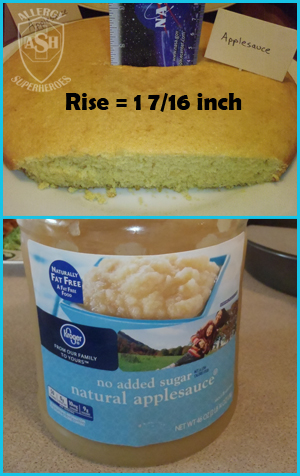 Egg Replacer Name: Applesauce
Egg Replacer Name: Applesauce
What is it? Cooked, pureed apples
Proportions: 1/4 cup unsweetened applesauce = 1 egg
Instructions: Add applesauce as you would eggs
Rise: 1 7/16 inch
Texture: Very soft and spongy, slightly chewy
Bind: Fairly crumbly
Taste: Slight fruity flavor
Pros: Easy to use; Available everywhere; Pretty good rise for a fruit replacer; Top 8 Allergen Free; Gluten Free; Vegan; Fruit flavor is subtle
Cons: Binding power isn’t all that great; Adds a fruit flavor you may not want in cake
Notes: Other fruit purees can also be used as egg replacers. They tend to produce moist cakes, but they usually crumble and rise can range from okay to non-existent. Plus, they will generally impart some of their flavor into the cake, so take great care in choosing a complimentary flavor–or choose a different replacer.
Our Observations:
Zax: Love it! Don’t taste the applesauce
Kal: Yummy
Eileen: Soft and spongy; has a fruity flavor
Dean: Can taste the applesauce; slightly chewy; very soft all the way to the edge
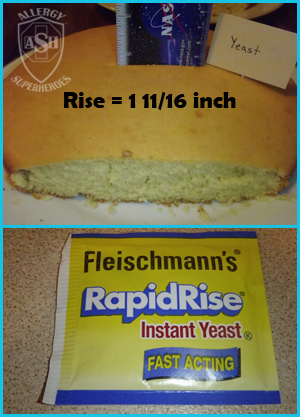 Egg Replacer Name: Yeast
Egg Replacer Name: Yeast
What is it? A tiny fungus capable of converting sugar to alcohol or carbon dioxide. It’s what makes your bread rise.
Proportions: 1 tsp Instant Yeast plus 1/4 cup warm water = 1 egg
Instructions: Dissolve yeast in warm water. Use Instant Yeast so it has time to rise–making bread takes longer than cake.
Rise: 1 11/16 inch
Texture: A little drier than regular cake, soft
Bind: A little crumbly, not much
Taste: Less sweet
Pros: Best rise of all non-egg cakes; Readily available at all grocery stores; Top 8 Allergen Free; Gluten Free; Vegan
Cons: Cake not as sweet; Have to dissolve the yeast, which takes longer
Notes: We all agreed that this didn’t quite taste like cake, it was less sweet. I later realized this is because yeast eats sugar and so it probably fed on the sugar in the cake. You may want to add extra sugar to a cake if you use yeast to help it rise.
Our Observations:
Zax: Crust is very soft; middle is very yummy; and I love it!
Kal: (no comment, he was getting tired)
Eileen: Roundest; closest to egg in rising; drier and/or not as sweet?; can smell the yeast but don’t taste it; very soft
Dean: Bottom is spongy; top not too bad; edge spongy; looks like a short cake; tasted a little off, less cake-like
 Egg Replacer Name: Gelatin
Egg Replacer Name: Gelatin
What is it? Proteins and peptides derived from bones, skin, and connective tissue of animals.
Proportions: 1 packet unflavored gelatin (~2 1/2 tsp) plus 2 Tbsp water = 1 egg
Instructions: Dissolve gelatin in warm water
Rise: 7/8 inch
Texture: Chewy, dense, and hard, with a thick, hard crust
Bind: Very strong!
Taste: Tastes a little off
Pros: Easy to find–available at most grocery stores with the Jell-O; Holds together really well; Top 8 Allergen Free; Gluten Free
Cons: Not Vegan; Has no rise; Produces a cake that doesn’t taste or feel much like cake
Notes: If you need an egg replacement where all you’re looking for is binding power (meatballs, maybe) then this would make a good egg replacement. In any sort of baking, this one isn’t worth your time.
Our Observations:
Zax: Crust is hard; middle is soft and yellow; and it’s yummy!
Kal: Crust is hard; Yum!
Eileen: Crust is thick, hard, and chewy; very dense; holds together well
Dean: Dense; harder on edges; soft in very middle; crust is definitely thicker, chewier; tastes okay
Summary
Our favorites:
Zax: Banana, Ener-G, Aquafaba, Vinegar and Baking Soda, Chia 1
Kal: Banana
Eileen: Aquafaba, then Flax 1
Dean: Flax 1 and Aquafaba 1, although the fruity ones were different and kind of neat
Rank for Leavening/Rise:
Best Risers: Yeast, Soy Protein Powder, Aquafaba, Flax 1
Next Best: Chia 1 and 2, Flax 2, Applesauce, Banana, Yogurt
Lower Rises: Tofu, Agar Agar, Ener-G
Flat: Seltzer water, Gelatin
Sunken: Vinegar and Baking Soda
Rank for Bind:
As Strong As (Or Stronger Than) Real Eggs: Chia, Gelatin
Decent with a few crumbs: Flax, Aquafaba, Soy Protein Powder, Seltzer Water, Yeast
Fairly crumbly: Ener-G, Agar Agar, Banana, Applesauce
Very crumbly/Falls Apart: Tofu, Vinegar and Baking Soda, Yogurt
A Note About Cost:
Almost all of the replacements above are cheaper than real eggs. One curse of food allergies is that we often have to pay more for safe foods than non-allergic folks pay for what we’re replacing–but this largely isn’t the case with eggs. Even if you cringe at the price of a package, remember that you’ll usually get several dozen “eggs” out of it, as opposed to $2-$4 for a dozen eggs unless they’re on sale–or higher, if you’re springing for Organic or Free-Range. So rejoice in this one wallet-saving benefit of the egg-free lifestyle!
Conclusions
As I stated at the beginning, there’s no clear winner. However, for the most egg-like performance without significantly changing the taste, the following replacers seem to come out on top:
Aquafaba
Flax Seeds
Soy Protein Powder
Chia Seeds
But if these don’t work for your dietary needs, remember that almost every one of the egg replacers tried here produced an edible cake. The only ones I would not recommend are: Gelatin, Vinegar and Baking Soda, and Tofu–and any fruit puree that you don’t want to taste in your cake. Also remember that if you use Yeast, you’ll probably want to add more sugar (or just lay the frosting on thick.)

My playlist for the day
Let me tell you, this experiment was an adventure! Dean occupied the boys all day long (occasionally breezing in to take a picture of me) while I listened to show tunes and followed a pattern of weigh, measure, mix, bake, wash, repeat. It took me all day, with me barely managing to eat any real food in between. And despite my early start, we didn’t taste the cakes until after the boys should have been in bed. Good thing it was summer!
It was worth it though, because now we have a comprehensive comparison of egg replacers, with all other variables controlled for, so there’s no confusion as to how they stack up! I’m sure you’ll be able to find one or more that will work for you. Happy Baking!
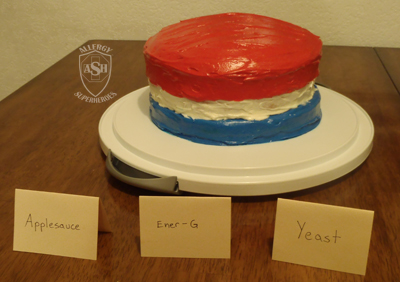
A patriotic cake, made to share with our family for the 4th of July. What else were we going to use all these cakes for?
p.s. We had cake in the freezer for MONTHS!!!!!





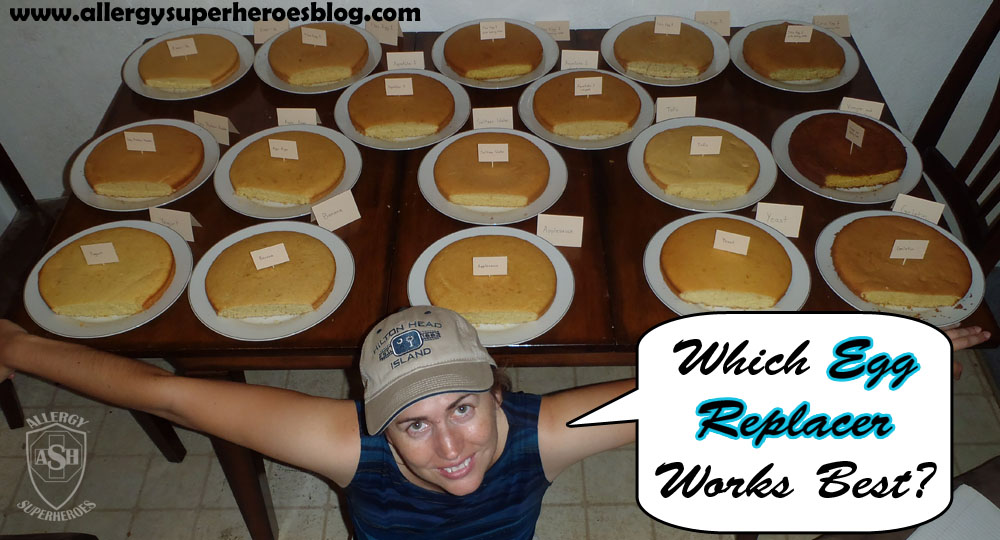
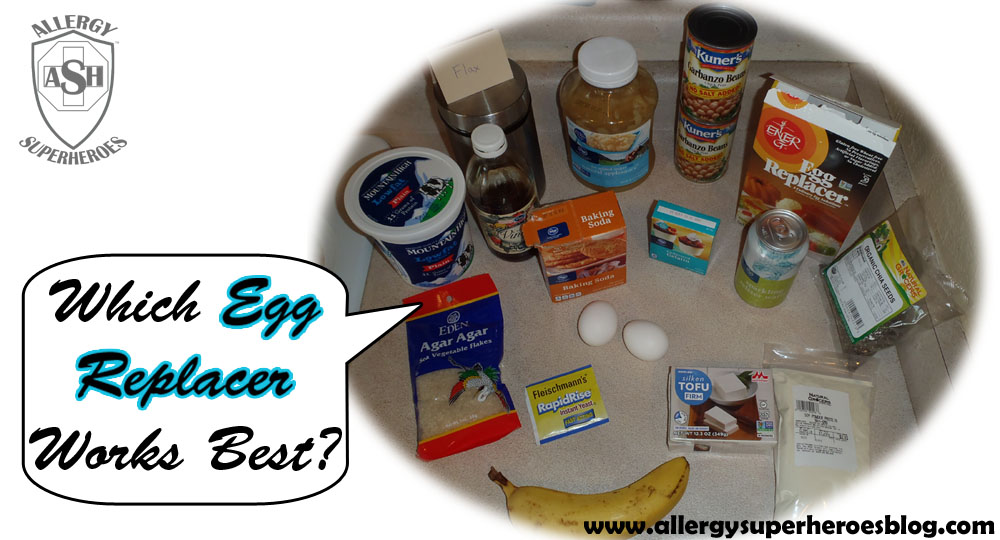


This was so thorough. Thank you.
Thanks! I appreciate it, hope you found something that helped 🙂
Amazing article! Thank you so much for the work!
You’re welcome! I’m glad to be of help 🙂
Thank you for all your work.
Very helpful.
If you need freezer space for some of those cakes … well ..
tuvm
😀 😀 You’ll have to come get them yourself 😉
Thanks, I’m glad to help people out!
Nice comparison, lots of work.
Have you tried “The Vegg”? They make several different egg replacers, one specifically for baking.
Thanks! After doing all this baking a while back, I’ve mostly stuck with flax and aquafaba, and Ener-G when I want something quick. A handful of replacers have come out since then, though the Vegg isn’t one I’ve heard of. Thanks
In addition to my peanut and tree nut allergies, I also have an unbaked egg allergy (meaning I can have eggs that are baked into cakes, cookies, even creme brulee’s, but cannot have them when they are fried, poached, scrambled etc)
While being allergy tested again many years ago, my allergist handed me a sheet that listed many of these egg replacements.. The one that I liked the most (and still use to this day) is like the vinegar and baking soda one except instead of baking soda, I use baking powder and some water.. So for every egg required, I use 1 teaspoon of baking powder, 1 teaspoon of vinegar and 1 tablespoon of water… It works everytime 🙂 I even prefer to use this replacement over eggs when making homemade brownies because I find the finished product is more softer and fudgier. When I used eggs, I found the finished product to be more firmer and cake like.
Our kiddo went years without being able to do baked egg, but two summers ago we discovered that he now could. We even joined a research study that is measuring how much eating baked egg regularly is changing his numbers and (hopefully) speeding him in growing out of egg. How far he will go remains to be seen. So we bake with egg now for his “egg doses,” but still do without egg for everything else. We like being able to safely eat the batter too, when it’s egg free!
Several people have told me they like the vinegar and baking soda method best, but mine was a total flop. I wondered if it was too dry, since an egg is roughly 1/4 cup and that only had 1 Tbsp of liquid. I may try again someday and mix it up, but I mostly use flax, aquafaba, and Ener-G these days. Thanks for commenting!
A commendable effort! I use quite a few substitutes myself and now I’ve learned some new ones. Thanks for sharing.
Thanks! I hope some of the new ones work out for you!
I LOVE that you did this!!! What I have found best is to add powdered egg replacer (we use Ener-G Foods or Bob’s Red Mill) AND a 4-ounce applesauce.
Thanks, fellow Kitchen Geek! 😀 We have done that in the past, though for this experiment I was trying to keep all other variables constant. We use Ener-G a lot, it’s our “just pull it out of the pantry” easy go-to. I wasn’t impressed with Bob’s Red Mill, but recently discovered that they’ve changed their recipe since the last time I tried them. There are actually quite a few more commercial replacers than there were just a year or two ago. I could do this again, but…. I’m tired. Maybe another time. 😉
Quite the day of baking for you. Thank you for taking this on. I was surprised to see that you used baking soda instead of baking powder with the flax egg. Baking soda causes a spread in your product while baking powder creates a lift or rise. Now I must try adding some baking powder to a flax egg the next time I make a cake that isn’t a wacky cake. Typically, I will use a vegan mayo or “Just mayo” in place of the egg. It doesn’t come out great but it’s been what I’ve been using. I have yet to delve into aquafaba.
I don’t know how I never replied to this, sorry. If you subscribed to replies, please know now that it wasn’t an intentional slight! And thanks for the info and ideas. I have yet to work up the courage to repeat this massive day of baking, but when I’m ready I’ve got several additional egg replacer, plus some I should probably repeat, ideas based on reader input. Thanks!
Seriously, you’re my hero. God bless you for sharing and saving the rest of us all this hard work!
Thank you! I’m glad to hear it’s helpful, happy baking!
Wonder how the chia/flax soaked with the Aquafaba would work.. On my list to try!
Since penning this post, I have heard of people making what they termed a “Super Egg,” which is the flax egg using aquafaba instead of water. I have yet to try it myself, but it sounds promising!
Exactly what I needed, thanks!
You’re welcome! Thanks for linking back!
Thank you for all the effort you put into this! I’ve been wondering what to sub for eggs in my 7Up cake recipe. You saved me from an expensive mistake.
You’re welcome! I hope you found something that worked!
Your mistake in the baking soda/vinegar trial: When I use it I use self-rising flour, then you only need 1/2 tsp. baking soda and 1 Tb. of vinegar. I get good rise and texture every time, not sunken.
Thanks for the input! I’ve been thinking of repeating a few of these and also trying a few new ones, but haven’t worked up the energy yet. Although this fix wouldn’t work for a boxed mix, and that was my great equalizer in this experiment. Many of these replacers work better in recipes designed around their specific chemistry, but here I wanted a rundown of replacers for people who don’t bake much and want to know what to expect with a box. Baking from scratch certainly gives us more options, but is intimidating to a lot of people, especially when they’re first starting out.
I wish I had seen this a couple months ago when we were making “practice” cakes for my sons first birthday. We’re not really bakers and after a few frustrating fails, went with cutting a watermelon in a cake shape. An unexpected bonus is thanks to your experiments, I learned of a new possibility—gelatin for meatballs and meatloaf!
I missed this until yesterday, sorry. I hope your kiddo enjoyed his watermelon cake! And that you’ll have some good ideas for the next time you try. 🙂
Thank you so much, this helped a lot! If you’re ever doing this again, I would be happy to see more combinations, like aquafaba+soy protein for example.
Thanks, glad to be able to help out! I do have a fairly extensive list of additional things to try now, based on reader feedback and other things I’ve learned since then. It’s a massive undertaking though, so I’m not sure when I’ll try it again. Stay tuned here though, because once it happens I’ll post it!
I want to thank you for all the great information you provided when you conducted this experiment. My son is both gluten free and egg free. While I have been cooking/baking gluten free for many years (the whole family is gluten free), egg free is new to me. I know that my results with gluten free flours may be entirely different from yours using wheat flour, but it helps to see how each of these egg replacers behaved. Since binders are a big issue with gluten free flours, I know NOT to use the ones that you identified as having poor binding capability. Your article also helps me to understand the results my mom got today with some bread she made for my son. We have been using Pamela’s Bread Mix (GF) along with Bob’s Red Mill egg replacer, and the bread rises well and tastes great. Today, we ran out of the Bob’s Red Mill egg replace and substituted Ener-G. The bread tasted okay, but didn’t rise as well; was difficult to pry out of the pan; was very moist, almost gummy; and chewier than bread made with Bob’s. Now I understand that the difference was likely in the different egg replacer we used.
Thanks for your comment, and glad to be able to help out! I have done some gluten free baking and I know it’s a whole animal unto itself–and with an egg-free kiddo, there are a lot of gluten free items that he can’t have because egg is used so extensively. I wish you success on your journey!
I have a question, would a combination of ener-g egg replacer and aquafaba be a mistake or make a perfect combo in a cake as far as rise, texture, and taste. What do you think?
Oh gosh, I’m sorry, between illness and kids being home for break, I completely didn’t see this. I’ve never heard of trying this particular combination, but I know of many people who use what they call an “Aquafaba Super Egg,” which is a flax egg using aquafaba instead of water to mix it up (same proportions, 1T to 3T.) I would say your combination is worth trying, if you use the aquafaba to hydrate the Ener-G instead of water. Nothing makes me expect it would perform worse, and hopefully you’d get a combination of the good benefits. If you try it out, please comment again and let me know how it went!
Thank you for this. I’m testing cakes to make for a bridal shower. I used applesauce the first time and the whole cake crumbled and broke apart when I tried to frost it and cut it. It was really moist and delicious, but yeah.. That won’t work. I’ll try aquafaba next. Thanks a bunch!
PS.. have you tried the “super egg” yet? (aquafaba and flax). thanks!
Thanks for the comments, and I hope I’ve given you the tools to make an awesome bridal shower cake! I have not tried the Super Egg yet, this sort of experiment is pretty time-consuming so I haven’t mustered the energy for wave #2. I’ve got several boxes of cake mix waiting for me in my pantry though, so hopefully soon. Lots of people from an Aquafaba fan group on Facebook swear by it!
Thank you for this awesome article. It, when paired with all of the comments above, should cover any options I want to try. I am very excited about trying aquafaba! Drain out aquafaba for egg replacer, pour beans into a food processor for hummus. Perfect!
You’re welcome 🙂 And that’s absolutely what we do–lots of hummus when using aquafaba. Fortunately, we love hummus!
Hi!
I was googling what to substitute eggs with duncan Hines cake mix, and read that you can also substitute eggs, oil AND liquid with either 1 15-ounce can of pumpkin or 1 12-ounce can of soda. Not sure if you’ve ever tried either of these. I haven’t tried it yet but am in a procrastinating rush to find the right egg replacer that is best for stacking cakes. I’m so thankful for finding your blog!
Hi, and thanks for your comment. Pumpkin will yield similar results to applesauce (though I’ve never used a puree to replace all add-ins) and soda will be the same as seltzer water (but will impart some of its flavor.) Both are included above, and you can see how they stack up to the rest.
Hi, I was searching for new ideas for making a boxed mix vegan and stumbled upon your post. Thank you for putting in so much time to compare all of these! This is the exact type of content that I needed. I’m going to attempt to make a cake and cupcakes using your suggestions. Thanks again!
Thanks for your comment, and glad to help! I wish you luck with your baking, and hope it comes out nicely on the first try!
Thank you, thank you, thank you! You did what I have been wanting to try for a few years now. I can’t imagine how time consuming and labor intensive this must have been. So grateful to be able to read about all the different caveats of each experiment. This is SO helpful! I’m off to try making an aquafaba cake! Btw, which did you find you liked better, an egg-replacement cake or the wacky cake? Thanks agsin!!
I apologize for neglecting my comments! In all honesty, most of the birthday cakes I make are the wacky cake. I tend to sculpt my cakes into fun shapes and I feel that it holds up better. However, I keep a combination of aquafaba, flax, and Ener-G on hand for cookies, pancakes, and anything else I may want to bake. Those are my go-tos!
I LOVE YOU for doing this!!!!!!!!!
THANK YOU.
You’re welcome! Glad to help!
I wonder how a mixture of flax egg 1 (using flax meal – no grinding), and seltzer water would turn out?
Interesting idea. Since doing this I’ve heard of the “Flax Super Egg,” which uses Aquafaba instead of water with the flax, but not this. Since you typically use the whole can of soda or seltzer with a box of mix, I’m not sure a few tablespoons would be enough. But it has more lift than just water, so it might work well!
Thank you for this article and all your hard work. I am new to baking period because I have an egg and dairy allergy and finding out how to bake was an overwhelming prospect. I now have much needed information to move forward and bake something!